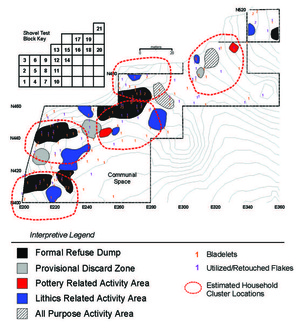| Jarrod Burks' dissertation, entitled Identifying Household Cluster and Refuse Disposal Patterns at the Strait Site: A Third Century A.D. Nucleated Settlement in the Middle Ohio River Valley (Burks 2004), considers how patterns of trash disposal can be used to assess the contemporaneity of residential structures. Jarrod examines artifact density data from shovel probes in light of a model of household-level trash disposal developed from ethnoarchaeological data, then compares the results to geophysical and excavation results. Portions of two structures were exposed. I have added a listing for the Strait site to the inventory for Ohio, and will include the site in the next version of the Database. The Strait site (33-Fa-156-158) is one of only a handful of "Middle Woodland - Late Woodland Transitional" sites in the Database. Sites of this age (i.e., arguably post-Hopewell, generally associated with projectile points belonging to the Lowe Cluster) are sometimes referred to in the literature as "late Middle Woodland" and other times as "early Late Woodland." Hence my decision to give them their own category. These sites represent a time of important change in the organizational structure of settlement during the Woodland period in the Ohio Valley. Read Jarrod's dissertation to find out more. | Above: Artifact cluster interpretations and proposed household clusters at the Strait site (Burks 2004: Figure B.64). |
|
0 Comments
Leave a Reply. |
AuthorAndrew A. White Archives
January 2016
Categories
All
|

 RSS Feed
RSS Feed
